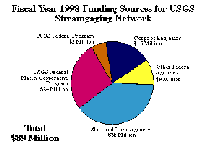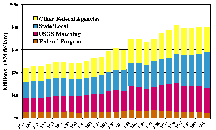|
|
A New Evaluation of
the USGS Streamgaging Network--A Report to Congress
One of the major virtues of the streamgaging network is its shared funding arrangement. The USGS partners with more than 800 Federal, State, and local agencies through the Federal-State Cooperative Water Program (Water Coop Program). The Water Coop Program was formalized in appropriations law in 1929 and has been reaffirmed by the Congress every year since. Programmatically, the Water Coop Program provides the majority of funds for operating streamgaging stations–about two-thirds of the total (fig. 11). Other Federal agencies provide 28 percent and the USGS Federal Program provides the remaining 6 percent.
 Larger image 136K, Gif format
|
|
Figure 11.–Diagram showing the distribution of
funding for the streamgaging network in 1998.
[D]
|
Over the longer term, the USGS Federal Program as a percentage of the total funds supporting stations also has declined (fig. 12). In 1974, the first year for which detailed funding data are available, the USGS Federal Program provided 11 percent of the total funds supporting the network. In 1998, this Program provided less than 6 percent, thereby reducing its relative influence by half. During this same period, the unmatched part of the Water Coop Program increased from less than 1 percent to its current level of 13 percent. Proportional funding from other Federal agencies increased slightly, from 25 percent to 28 percent, during this period.
 Larger image 208K, Gif format
|
| Figure 12.–Graph showing annual distribution of funding for the streamgaging network, 1974-1998. (Adjusted to 1974 using the GDP Product Index of Non-Defense Government Expenditures by Fiscal Year. Source: Bureau of Economic analysis, Department of Commerce.)] [D] |
The real resources available to operate the streamgaging network (funds from all sources, adjusted for inflation) have been relatively static, particularly since 1992. We also have been investing in new technology to replace outdated equipment and to meet the demand for real-time data. The net result is a decline in the total number of stations and a commensurate decline in the attainment for the Federal goals.
The declining relative share of USGS funding also has an impact. The USGS staff annually engages all potential funding agencies in discussions of possible network changes based on changing needs and changing availability of funds on all sides. The role of the USGS in these negotiations is to foster the Federal goals and apply the USGS funds towards the furtherance of these goals. The best outcome of these negotiations is a network configuration that satisfies the Federal goals and the goals of the funding partners. However, the smaller the share of the total funds that the USGS can bring to those negotiations, the poorer will be the bargaining position of the USGS to achieve the Federal goals.
|
Real resources available to operate the streamgaging network have
remained static and the USGS share of this funding has been declining in
recent years.
|
The smaller the share of the total funds that the USGS can bring to
negotiations, the poorer will be the bargaining position of the USGS to
achieve the Federal goals.
|
| Contents |
| Introduction | Purpose | Evaluation | Funding |
| Modernization | Future | Conclusions | References |
| USGS Home Page | USGS Water Resources |
U.S. Department of the Interior, U.S. Geological Survey